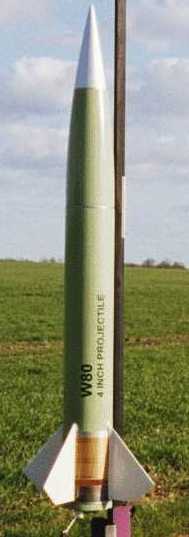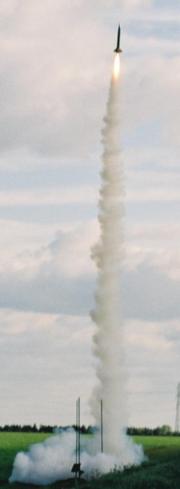| Manufacturer: | Yank Enterprises |
 Brief:
Brief:
Fiberglassed airframe and fins, external fin can assembly, removable bulkhead
in nosecone.
Modifications:
Using my trusty Foodsaver I vacuum bagged both fins and body tube using one
layer of 6oz fiberglass with West Systems Epoxy. Before vacuum bagging the fins
I used my Dremel sanding drum to bevel the fins.
After the body tube had completely cured I continued the existing slots for the fins down to the bottom to allow for insertion of a fin-can assembly.
The fin can was created by first gluing the centering rings to the motor mount (as is standard in most kits). The fins were subsequently attached using 5 minute epoxy for an initial bond with subsequent reinforcement using Kevlar® tape and un-thickened West Systems Epoxy. This created a solid fin to motor bond which is unlikely to shred. The resulting fin-can was then inserted into the body tube and epoxied in place using un-thickened epoxy then filleted from above and below. External fillets for the fins were achieved using epoxy thickened with microballoons.
Finally, the nosecone was altered to provide a stronger mount point. As
shown in the diagram my plan was to create a removable bulkhead which was
capable of withstanding the recovery forces and yet allow for access to the
nosecone interior (just in case I need more weight later or wanted to put in a
tracking device). The nose cone base was cut using a hobby knife (surprising
how soft the plastic is). A 6mm all-thread bolt was then cut to length and
threaded with a washer and bolt at one end. The resulting part (nut/washer end)
was then heated on a gas stove for a few seconds. While still hot it was then
inserted all the way into the top of the nosecone with the washer and nut
assembly touching the inside tip of the nosecone.
 The heating of the part should
partially melt the inside of the nosecone tip allowing the all-thread, nut and
washer to bite into the plastic. You need to keep the nosecone pointing straight
down to ensure proper alignment of the all-thread.
The heating of the part should
partially melt the inside of the nosecone tip allowing the all-thread, nut and
washer to bite into the plastic. You need to keep the nosecone pointing straight
down to ensure proper alignment of the all-thread.
Next I poured un-thickened epoxy (about 1 oz) into the nosecone until it completely encased the nut and washer in the tip. This was then set to cure overnight. Once cured I cut a piece of carbon rod (you can get these at any kite supplier -- they are sometimes called 'carbon rod spars') to fit over the all-thread. The rod was cut to allow for 1/2" of the all-thread to poke through. I next took a 4" coupler bulk-plate and drilled holes to allow for the connection of a 1/2" u-bolt (very strong). The middle hole of the bulk-plate (already drilled) was used to fit over the exposed all-thread (the bulkhead is actually inside the shoulder of the nosecone). Connection to the all-thread is achieved using a standard 6mm wing-nut with a washer on both sides of the bulkhead. The carbon rod and washer stop the bulkhead from slipping down into the nosecone.
Finally to provide a gas-proof seal I used some instant-gasket (you get this at any automotive shop) round the outside of the bulkhead to provide a seal against the interior wall of the nosecone.
All that remained was the finish.
Construction:
Kit Includes:
- 1 - 4" flexible phenolic body tube
- 4 - plywood fins
- 2 - 1/4" plywood centering rings
- 1 - Nosecone
- 1 - 15' 9/16" tubular nylon shock cord
- ORDERED WITHOUT PARACHUTE
- NO DECALS included.
The packaging was a standard bag with all parts accounted for. Instructions where easy to follow but not used since this was a MOD anyway. The rocket built stock would be very simple to build with through the wall fin attachment. Since I fiberglassed the rocket it was necessary to apply a finish coat to cover the weave of the fabric. A top layer of 'SuperFil' was applied using a plastic squeegee. I love this stuff as it is super light and easy to sand. When dried it is rock hard. Since this is a sport rocket there is no painting guide. So I decided to model mine on a W79 8" Artillery shell (picture included 1 2). I had some clear vinyl decals made up and use a military green paint to give it that 'army ordinance' look. I have given my rocket the name of 'W80 4" Projectile'.

 Flight:
Flight:
My rockets all tend to be on the heavy side since I always reinforce them. As a
result I never look at the recommended motors list. Instead I use RockSim to
test for stability and motor selection. The first and so far only flight was on
an I211W-10. Perfectly straight in a 15mph wind. The predicted height was 2900
feet and I could hardly see it when it deployed the chute but it looked to be
just after apogee. The rocket drifted about 3/4" of a mile and soft landed
in a field without a scratch to show for it.
Summary:
PROs: YANK kits are very nice. I like the flexible phenolic and the ability to
buy without a chute. Fin material is first rate and the nosecone is one of the
better to be found.
CONs: can't think of any except they could provide a decal or two. After all that is what makes BSD rockets so nice.
Other:
Build it like you are flying an M and you won't have to worry about a shred.
Next stop--J350W
Other Reviews
- Yank Enterprises The Bullet By Nick Esselman
(07/06/00) I'm a big fan of what I call "stubby" rockets, which have a 10:1 Length to Diameter ratio or less. So when I saw Yank Enterprises' "The Bullet" I wanted to give it a try. This is also my first Yank Enterprises kit so that would also be a new experience. See my 4" Stubby Rocket Comparison Page The Bullet is not a complicated looking rocket, nor ...
 |
 |
Flights
Sponsored Ads
 |
 |

![Zank Me Yank Me Crank Me [Explicit] Zank Me Yank Me Crank Me [Explicit]](https://m.media-amazon.com/images/I/51VQAh6GrKL._SL500_.jpg)


![Yanks [DVD] Yanks [DVD]](https://m.media-amazon.com/images/I/51+CdnXk4eL._SL500_.jpg)






